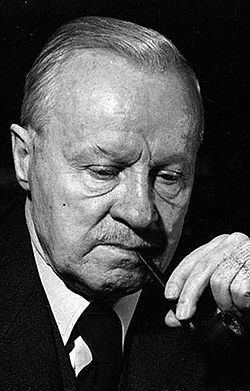Preceded by Kyosti Kallio Role Finnish Politician | Name Vaino Tanner Succeeded by Juho Sunila | |
 | ||
President Lauri Kristian Relander Political party Social Democratic Party Died April 19, 1966, Helsinki, Finland Party Social Democratic Party of Finland Children Heikki Tanner, Anni Tanner, Liisa Tanner, Mikko Tanner, Eeva Tanner, Olli Tanner, Aili Tanner, Maija Tanner Books Outlines of the Geography, Life & Customs of Newfoundland-Labrador (The Eastern Part of the Labrador Peninsula): Based Upon Observations Made During the Finland-Labrador Expedition in 1937, and the Tanner Labrador Expedition in 1939, and Upon Information Available in the Literature and Cartography | ||
Vaino Tanner (12 March 1881 – 19 April 1966; surname until 1895 Thomasson) was a leading figure in the Social Democratic Party of Finland, and a pioneer and leader in the cooperative movement in Finland. He was Prime Minister of Finland in 1926–1927.
Tanner was born in Helsinki. He did not participate in the Finnish Civil War, maintaining a neutral attitude. When the war ended he became Finland's leading Social Democratic Party (SDP) politician, and a strong proponent of the parliamentary system. His main achievement was the rehabilitation of the SDP after the Civil War. Vaino Tanner served as Prime Minister (1926–1927), Minister of Finance (1937–1939), Foreign Minister (1939–1940), and after the Winter War Minister of Trade (1940–1942). This final move was due to Soviet pressure.
Vaino Tanner's legacy is in his directing the Finnish working class from the revolutionary ideal towards pragmatic progress through the democratic process. Under his leadership the Social Democrats were trusted to form a minority government already less than 10 years after the bloody civil war. Tanner’s minority socialist government passed a series of important social reforms during its time in office, which included a liberal amnesty law, reduced duties on imported foods, and pension and health insurance laws.
During President Relander's brief illness Tanner, who held the post of prime minister, was even the acting President and Commander-In-Chief. In this role he even received the parade of the White guards on the 10th anniversary of the White victory. This was perceived as a remarkable development at the time. During the 1930s and 1940s, the Social Democrats formed several coalition governments with the Agrarian party (see, for example, Seppo Zetterberg et al., eds., A Small Giant of the Finnish History / Suomen historian pikkujattilainen, Helsinki: WSOY, 2003). In the Winter War Vaino Tanner was the foreign minister. Vaino Tanner's leadership was very important in forming the grounds and creating the Spirit of the Winter War which united the nation.
To accommodate the Soviet Union when the Continuation War ended, Vaino Tanner was tried for responsibility for the war in February 1946, and sentenced to five years and six months in prison.
After the Continuation War, and while still in prison, Tanner became the virtual leader of a faction of the SDP which had strong support from the USA. This faction eventually came out on top after a great deal of internal party strife lasting for much of the 1940s.
